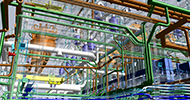While a recent Engineering.com article cited the major growth of additive manufacturing of parts in aerospace manufacturing, the unspoken subtext to this important subject is the massive amounts of data needed for prototyping tolerance testing, and other preproduction QC/QA processes. With 3D laser scanning an integral part of that process, the eventual point cloud processing and the accuracy based on point density is clearly an accuracy fulcrum point in aerospace manufacturing.
Point cloud processing and the laser scanning process go far beyond just additive manufacturing for rapid prototyping and production as it is increasingly integral to the entire production lifecycle. That is why understanding how point cloud processing is an important part of the aircraft manufacturing process requires some basic knowledge about how it works, and how point density impacts accurate design and production.
What Is Point Cloud Processing?
Point clouds are dense groups of 3D data points defined by X, Y, and Z coordinates that digitally replicate the project for design and construction. They make up a virtualized representation of the returned laser signal from the scanning line path of the physical representation of the external surface of a part. Every point represents a specific point on the surface, so the closer the points and themore of them, the greater the potential accuracy.
Point cloud files support the design process by providing real-world context where you can recreate the referenced objects or insert additional models. Once a point cloud is attached to a drawing, you can use it as a guideline for drawing, change its display, or apply a color stylization to distinguish different features.
A high degree of accuracy and point cloud density enables a greater flexibilityin terms of manipulating point components to change the look and geometry of the point cloud for design, production and aerodynamic considerations and testing. The ability of the software to ensure that the point cloud configuration and makeup is always retained for comparison purposes is a major boon to the process so that new information can be gleaned and input for more accurate designs.
Point Cloud Processing Benefits Within Aerospace Manufacturing
Whether it is OEM parts development/production, replacement parts, or design prototyping, aerodynamics experts need a very accurate parts data map for importing into engineering analysis tools to obtain real aerodynamicperformance. Clearly accuracy is paramount at all stages of design and throughout the production lifecycle. This is where the maximum point density of the laser scanner, and ultimately that of the point cloud, are crucial to that accuracy.














